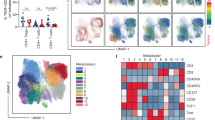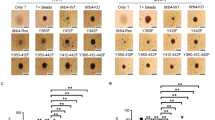Abstract
Lymphocyte function–associated antigen 1 (LFA-1) is relatively nonadhesive on resting lymphocytes; however, the mechanisms underlying changes in its adhesiveness are poorly understood. In this study, we generated a Jurkat T cell clone, J+hi1.14, that contained low amounts of mRNA for RhoH, a leukocyte-specific inhibitory Rho family member. J+hi1.14 cells expressed constitutively adhesive LFA-1 and the cells bound spontaneously to intracellular adhesion molecules 1, 2 and 3. Reconstitution of RhoH mRNA expression in J+hi1.14 cells reverted the adhesion phenotype to that of wild-type. We obtained similar results using RNA interference in peripheral blood lymphocytes. These data demonstrate that RhoH is required for maintenance of lymphocyte LFA-1 in a nonadhesive state.
This is a preview of subscription content, access via your institution
Access options
Subscribe to this journal
Receive 12 print issues and online access
$209.00 per year
only $17.42 per issue
Buy this article
- Purchase on Springer Link
- Instant access to full article PDF
Prices may be subject to local taxes which are calculated during checkout








Similar content being viewed by others
Accession codes
References
Springer, T.A. Adhesion receptors of the immune system. Nature 346, 425–434 (1990).
Marlin, S.D. & Springer, T.A. Purified intercellular adhesion molecule-1 (ICAM-1) is a ligand for lymphocyte function-associated antigen 1 (LFA-1). Cell 5, 813–819 (1987).
Staunton, D.E., Dustin, M.L. & Springer, T.A. Functional cloning of ICAM-2, a cell adhesion ligand for LFA-1 homologous to ICAM-1. Nature 339, 61–64 (1989).
de Fougerolles, A.R., Stacker, S.A., Schwarting, R. & Springer, T.A. Characterization of ICAM-2 and evidence for a third counter-receptor for LFA-1. J. Exp. Med. 174, 253–267 (1991).
Ostermann, G., Weber, K.S., Zernecke, A., Schroder, A. & Weber, C. JAM-1 is a ligand of the β2 integrin LFA-1 involved in transendothelial migration of leukocytes. Nat. Immunol. 3, 151–158 (2002).
Tagaki, J. & Springer, T.A. Integrin activation and structural rearrangement. Immunol. Rev. 186, 141–163 (2002).
Hogg, N., Henderson, R., Leitinger, B., Porter, A. & Stanley, P. Mechanisms contributing to the activity of integrins on leukocytes. Immunol. Rev. 186, 164–171 (2002).
Liddington, R.C. & Ginsberg, M.H. Integrin activation takes shape. J. Cell Biol. 158, 833–839 (2002).
Arnaout, M.A. Integrin structure: new twists and turns in dynamic cell adhesion. Immunol. Rev. 186, 125–140 (2002).
Hynes, R.O. Integrins: Bidirectional, allosteric signaling machines. Cell 110, 673–687 (2002).
Rothlein, R. & Springer, T.A. The requirement for lymphocyte function-associated antigen 1 in homotypic leukocyte adhesion stimulated by phorbol ester. J. Exp. Med. 163, 1132–1149 (1986).
Chatila, T.A., Geha, R.S. & Arnaout, M.A. Constitutive and stimulus-induced phosphorylation of CD11/CD18 leukocyte adhesion molecules. J. Cell. Biol. 10, 3435–3444 (1989).
van Kooyk, Y., Weder, P., Heije, K. & Figdor, C.G. Extracellular Ca2+ modulates leukocyte function-associated antigen-1 cell surface distribution on T lymphocytes and consequently affects cell adhesion. J. Cell Biol. 124, 1061–1070 (1994).
Dustin, M.L. & Springer, T.A. T-cell receptor cross-linking transiently stimulates adhesiveness through LFA-1. Nature 341, 619–624 (1989).
Szabo, M.C., Butcher, E.C., McIntyre, B.W., Schall, T.J. & Bacon, K.B. RANTES stimulation of T lymphocyte adhesion and activation: role for LFA-1 and ICAM-3. Eur. J. Immunol. 27, 1061–1068 (1997).
Weber, K.S., Klickstein, L.B., Weber, P.C. & Weber, C. Chemokine-induced monocyte transmigration requires cdc42-mediated cytoskeletal changes. Eur. J. Immunol. 28, 2245–2251 (1998).
Larson, R.S., Hibbs, M.L. & Springer, T.A. The leukocyte integrin LFA-1 reconstituted by cDNA transfection in a nonhematopoietic cell line is functionally active and not transiently regulated. Cell Regul. 1, 359–367 (1990).
Johnston, S.C., Dustin, M.L., Hibbs, M.L. & Springer, T.A. On the species specificity of the interaction of LFA-1 with intercellular adhesion molecules. J. Immunol. 145, 1181–1187 (1990).
O'Toole, T.E. et al. Integrin cytoplasmic domains mediate inside-out signal transduction. J. Cell Biol. 124, 1047–1059 (1994).
Weber, C., Alon, R., Moser, B. & Springer, T.A. Sequential regulation of α4β1 and α5β1 integrin avidity by CC chemokines in monocytes: implications for transendothelial chemotaxis. J. Cell Biol. 134, 1063–1073 (1996).
Li, X. et al. The hematopoiesis-specific GTP-binding protein RhoH is GTPase deficient and modulates activities of other Rho GTPases by an inhibitory function. Mol. Cell. Biol. 22, 1158–1171 (2002).
Dallery, E. et al. TTF, a gene encoding a novel small G protein, fuses to the lymphoma-associated LAZ3 gene by t(3,4) chromosomal translocation. Oncogene. 10, 2171–2178 (1995).
Cherry, L.K., Weber, K.S.C. & Klickstein, L.B. A dominant Jurkat T cell mutation that inhibits LFA-1-mediated cell adhesion is associated with increased cell growth. J. Immunol. 167, 6171–6179 (2001).
Rubinson, D.A. et al. A lentivirus-based system to functionally silence genes in primary mammalian cells, stem cells and transgenic mice by RNA interference. Nat. Genet. 33, 401–406 (2003).
Weber, K.S.C., York, M.R., Springer, T.A. & Klickstein, L.B. Characterization of lymphocyte function-associated antigen 1 (LFA-1) deficient T cell lines. The αL and β2 subunits are interdependent for cell surface expression. J. Immunol. 158, 273–279 (1997).
Liu, L., Schwartz, B.R., Lin, N., Winn, R.K. & Harlan, J.M. Requirement for Rho A kinase activation in leukocyte de-adhesion. J. Immunol. 169, 2330–2336 (2002).
Giagulli, C. et al. RhoA and zeta PKC control distinct modalities of LFA-1 activation by chemokines: critical role of LFA-1 affinity triggering in lymphocyte in vivo homing. Immunity. 20, 25–35 (2004).
Weber, K.S. et al. Dual role of H-Ras in regulation of lymphocyte function antigen-1 activity by stromal cell-derived factor-1α: implications for leukocyte transmigration. Mol. Biol. Cell. 12, 3074–3086 (2001).
Geiger, C. et al. Cytohesin-1 regulates β-2 integrin-mediated adhesion through both ARF-GEF function and interaction with LFA-1. EMBO J. 19, 2525–2536 (2000).
Liu, L. et al. The GTPase Rap1 regulates phorbol 12-myristate 13-acetate-stimulated but not ligand-induced β1 integrin-dependent leukocyte adhesion. J. Biol. Chem. 277, 40893–40900 (2002).
Sebzda, E., Bracke, M., Tugal, T., Hogg, N. & Cantrell, D.A. Rap1A positively regulates T cells via integrin activation rather than inhibiting lymphocyte signaling. Nat. Immunol. 3, 251–258 (2002).
Shimonaka, M. et al. Rap1 translates chemokine signals to integrin activation, cell polarization, and motility across vascular endothelium under flow. J. Cell Biol. 161, 417–427 (2003).
Chang, W., Hubbard, S.C., Friedel, C. & Ruley, H.E. Enrichment of insertional mutants following retrovirus gene trap selection. Virology 193, 737–747 (1993).
Soriano, P., Cone, R.D., Mulligan, R.C. & Jaenisch, R. Tissue-specific and ectopic expression of genes introduced into trangenic mice by retroviruses. Science 234, 1409–1413 (1986).
Markowitz, D., Goff, S. & Bank, A. Construction and use of a safe and efficient amphotropic packaging cell line. Virology 167, 400–406 (1988).
Siebert, P.D., Chenchik, A., Kellogg, D.E., Lukyanov, K.A. & Lukyanov, S.A. An improved PCR method for walking in uncloned genomic DNA. Nucleic Acids Res. 23, 1087–1088 (1995).
Lennon, G., Auffray, C., Polymeropoulos, M. & Soares, M.B. The I.M.A.G.E. consortium: an integrated molecular analysis of genomes and their expression. Genomics. 33, 15–52 (1996).
Otabor, I. et al. A role for lipid rafts in C1q-triggered O2− generation by human neutrophils. Mol. Immunol. 41, 185–190 (2004).
Changelian, P.S., Jack, R.M., Collins, L.A. & Fearon, D.T. PMA induces the ligand-independent internalization of CR1 on human neutrophils. J. Immunol. 134, 1851–1858 (1985).
Petruzzelli, L., Maduzia, L. & Springer, T.A. Activation of lymphocyte function-associated molecule-1 (CD11a/CD18) and Mac-1 (CD11b/CD18) mimicked by an antibody directed against CD18. J. Immunol. 155, 854–866 (1995).
Rothlein, R., Dustin, M.L., Marlin, S.D. & Springer, T.A. A human intercellular adhesion molecule (ICAM-1) distinct from LFA-1. J. Immunol. 137, 1270–1274 (1986).
Landis, R.C., Bennett, R.I. & Hogg, N. A novel LFA-1 activation epitope maps to the I domain. J. Cell Biol. 120, 1519–1527 (1993).
Andrew, D. et al. KIM185 a monoclonal antibody to CD18 which induces a change in the conformation of CD18 and promotes both LFA-1- and CR3-dependent adhesion. Eur. J. Immunol. 23, 2217–2222 (1993).
Kozak, M. Point mutations define a sequence flanking the AUG initiator codon that modulates translation by eukaryotic ribosomes. Cell 44, 283–292 (1986).
Ory, D.S., Neugeboren, B.A. & Mulligan, R.C. A stable human-derived packaging cell line for production of high titer retrovirus/vesicular stomatitis virus G pseudotypes. Proc. Natl. Acad. Sci. USA 93, 11400–11406 (1996).
Southern, E.M. Detection of specific sequences among DNA fragments separated by gel electrophoresis. J. Mol. Biol. 98, 503–517 (1975).
Thomas, P.S. Hybridization of denatured RNA and small DNA fragments transferred to nitrocellulose. Proc. Natl. Acad. Sci. USA 77, 5201–5205 (1980).
Acknowledgements
We thank X. Bu for technical assistance. Supported by National Institutes of Health (F32AR08632 to L.K.C., R01DK047636 to B.L. and R01AR47243 to L.B.K.), the Leukemia and Lymphoma Society (B.L.), the Lymphoma Research Foundation (X.L.) and the Arthritis Foundation (P.S.).
Author information
Authors and Affiliations
Corresponding author
Ethics declarations
Competing interests
The authors declare no competing financial interests.
Rights and permissions
About this article
Cite this article
Cherry, L., Li, X., Schwab, P. et al. RhoH is required to maintain the integrin LFA-1 in a nonadhesive state on lymphocytes. Nat Immunol 5, 961–967 (2004). https://doi.org/10.1038/ni1103
Received:
Accepted:
Published:
Issue Date:
DOI: https://doi.org/10.1038/ni1103
This article is cited by
-
ISG20L2: an RNA nuclease regulating T cell activation
Cellular and Molecular Life Sciences (2023)
-
Chemokines, their receptors and human disease: the good, the bad and the itchy
Immunology & Cell Biology (2015)
-
The insider's guide to leukocyte integrin signalling and function
Nature Reviews Immunology (2011)
-
Mechanisms and functions for the duration of intercellular contacts made by lymphocytes
Nature Reviews Immunology (2009)
-
Rho family GTPases and their regulators in lymphocytes
Nature Reviews Immunology (2009)



